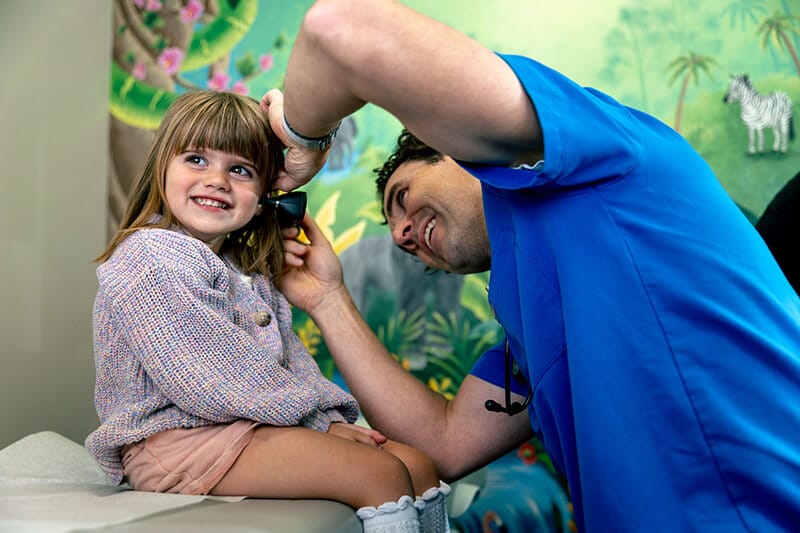People usually associate braces with those awkward teenage years, but the American Association of Orthodontists (AAO) recommends that kids visit an orthodontist by age seven. Early orthodontic treatment can help address several dental issues like narrow arches, lost teeth, misaligned teeth, and more.
In addition to the aesthetic benefits, braces can also improve oral health, make eating and speaking easier, improve your child’s confidence, and prevent dental problems in the future. Orthodontic treatment typically takes place between the ages of 8 and 14, when your child’s teeth and jaw are still maturing and malleable. Early orthodontic intervention provides an opportunity to identify and address dental problems before they advance into more severe problems in adulthood.
The 7 Most Common Signs Your Child Should Visit the Orthodontist
Orthodontic treatment can correct a wide range of malocclusions, the technical term for a “bad bite.” As your child grows and develops, keep an eye out for anything out of place in the teeth or jaw. It’s a good idea to visit an orthodontist by age seven, even if your child’s teeth appear straight, these are the most common signs your child might benefit from orthodontic treatment.
1. Crowded or crooked teeth: This is the most common reason for braces. Crooked or overcrowded teeth can make it difficult to keep teeth clean and negatively impact confidence. Children with crooked teeth have an increased risk of tartar buildup, gum disease, cavities, and tooth decay.
Teeth can become crooked or crowded if baby teeth don’t fall out correctly or if there isn’t enough room in your child’s mouth. Depending on the layout of the teeth and the available space in the mouth, crowded or crooked teeth may be fixed with braces alone or may need additional intervention like palate expanders or spacers. That sort of treatment is easiest to accomplish when the jaw and teeth are still growing.
2. Gaps between teeth: Gaps, also known as diastema, are common in young children, as baby teeth often aren’t large enough to fill the space of a growing mouth. As adult teeth come in, gaps will usually close up on their own. Visit an orthodontist if permanent teeth have already come in and gaps are still present. It’s worth noting that sometimes, gaps between teeth are a normal part of dental development, and braces may or may not be needed.
Gaps are most common between the front two teeth, known as midline diastema, and may be the result of gum disease or may be purely aesthetic. If braces are the best course of action, midline diastema is one of the most treatable orthodontic issues!
3. Losing baby teeth early or late: While every child is different and the precise timeline will vary, most kids start losing their baby teeth by age six, and they’ve lost the last one by age 13. When things go according to plan, the baby teeth stay in place until pushed out by an adult tooth, and everything stays in its proper place.
Baby teeth can fall out early due to tooth decay or an accident before the adult tooth is ready. When that happens, nearby teeth can shift to fill the available space. If baby teeth fall out too late, adult teeth may erupt into a position they don’t belong. In either case, braces may be needed to adjust tooth positions.
4. Excessive thumb sucking or pacifier use: Sucking on a thumb, fingers, pacifier, or other objects is a normal baby behavior and part of childhood development. It’s one of the earliest ways babies learn to soothe themselves, and sometimes they lean into it a little too much. Whether or not your child will need orthodontic treatment for thumb sucking depends on how often they suck, how much pressure they’re applying, and how old they are when they stop sucking.
As your child grows, thumb-sucking should cease on its own, usually between the ages of two and four. If it persists, thumb sucking could cause dental problems down the line, requiring orthodontic treatment.
5. Underbite or overbite: In a typical bite, the top teeth rest just in front of the bottom teeth and overhang them just slightly so that the tops of the bottom teeth aren’t visible when closed. An overbite is when this is taken to an extreme, and the bottom teeth are almost totally covered.
By contrast, an underbite is when the bottom teeth stick out in front, covering the top teeth. Overbites and underbites range from mild to severe and can cause uneven wear and tear on the front teeth, making them more likely to chip or break. It may also be an indication of poor jaw development.
6. Trouble speaking or chewing: Misaligned teeth can impact your child’s self-esteem but can also negatively impact their ability to chew and eat comfortably and effectively. Depending on the severity, misaligned teeth may cause your child to bite their tongue or cheek frequently while chewing, causing pain.
Likewise, misaligned teeth or jaws can negatively impact speech, making it difficult for your child to communicate clearly. Trouble eating or speaking may indicate an open bite, crossbite, or another malocclusion of the teeth and jaw.
7. Misaligned jaw: When most people think about braces, they think about correcting crooked teeth, but orthodontic treatment can also address jaw misalignments. When the top and bottom jaws aren’t aligned correctly, it can lead to changes in the shape of the face and more severe dental complications in the future.
A jaw misalignment can cause an open bite, making it difficult to eat and speak. It may also cause pain and difficulty sleeping. Jaw misalignment may be congenital, developmental, or the result of injury and can lead to tooth erosion, gum disease, lost teeth, and more. Treatment options depend on the cause and severity of misalignment. Some jaw misalignments may require surgery, while others can be treated with braces.
Your child’s orthodontist can help you create the best action plan for your child’s unique situation. There’s no better treatment than early intervention! Be sure to check out our orthodontic offer and request a free consultation today.




